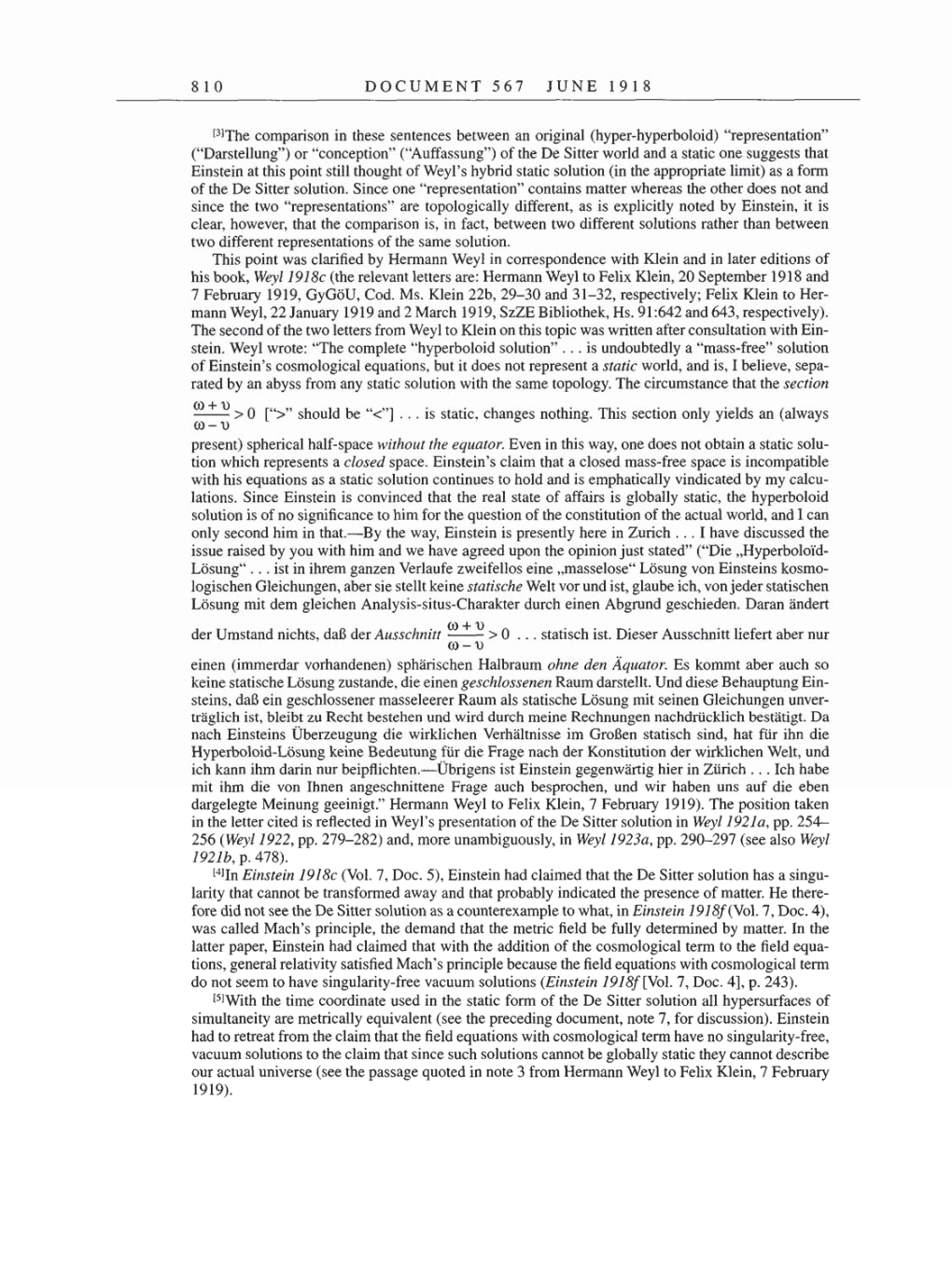810 DOCUMENT
567
JUNE
1918
[3]The
comparison
in these sentences between
an original (hyper-hyperboloid)
"representation"
("Darstellung")
or
"conception" ("Auffassung")
of
the
De
Sitter world and
a
static
one suggests
that
Einstein at this
point
still
thought
of
Weyl’s hybrid
static solution
(in
the
appropriate limit) as a
form
of
the
De Sitter solution. Since
one
"representation"
contains
matter
whereas the other does
not
and
since the two "representations"
are topologically
different,
as
is
explicitly
noted
by
Einstein,
it is
clear, however,
that the
comparison
is,
in
fact,
between
two
different solutions
rather
than between
two
different
representations
of
the
same
solution.
This
point
was
clarified
by
Hermann
Weyl
in
correspondence
with Klein and in later editions
of
his
book,
Weyl
1918c
(the
relevant letters
are:
Hermann
Weyl
to Felix
Klein,
20
September
1918 and
7
February 1919, GyGöU,
Cod. Ms. Klein
22b,
29-30
and 31-32,
respectively;
Felix Klein to Her-
mann
Weyl,
22
January
1919 and 2 March 1919, SzZE Bibliothek, Hs. 91:642 and 643,
respectively).
The second
of
the two letters from
Weyl
to
Klein
on
this
topic
was
written
after
consultation with
Ein-
stein.
Weyl
wrote: "The
complete
"hyperboloid
solution"
...
is
undoubtedly
a
"mass-free" solution
of
Einstein’s
cosmological equations,
but it does
not
represent a
static
world,
and is,
I believe, sepa-
rated
by an abyss
from
any
static solution with the
same topology.
The circumstance that the section
w+v/w-v
0
[“"
should be
""]
...
is static,
changes nothing.
This section
only yields an (always
present) spherical half-space
without the
equator.
Even in this
way, one
does
not
obtain
a
static solu-
tion which
represents a
closed
space.
Einstein’s claim that
a
closed mass-free
space
is
incompatible
with his
equations as a
static solution continues
to
hold and is
emphatically
vindicated
by my
calcu-
lations. Since Einstein is convinced that the real
state
of
affairs is
globally
static,
the
hyperboloid
solution is
of
no significance
to
him for the
question
of
the constitution
of
the actual
world,
and I
can
only
second him in
that.-By
the
way,
Einstein
is
presently
here in Zurich
...
I
have
discussed
the
issue raised
by you
with
him and
we
have
agreed upon
the
opinion
just
stated"
("Die
"Hyperboloid-
Lösung"
...
ist in ihrem
ganzen
Verlaufe zweifellos eine "masselose"
Lösung von
Einsteins kosmo-
logischen Gleichungen,
aber sie stellt keine
statische
Welt
vor
und
ist,
glaube
ich,
von
jeder
statischen
Lösung
mit dem
gleichen
Analysis-situs-Charakter
durch einen
Abgrund geschieden.
Daran ändert
der Umstand
nichts,
daß der Ausschnitt
w+v/w-v
0
...
statisch ist. Dieser Ausschnitt liefert aber
nur
einen
(immerdar vorhandenen) sphärischen
Halbraum ohne den
Äquator.
Es kommt aber auch
so
keine statische
Lösung
zustande,
die einen
geschlossenen
Raum darstellt. Und diese
Behauptung
Ein-
steins,
daß ein
geschlossener
masseleerer Raum als statische
Lösung
mit seinen
Gleichungen unver-
träglich
ist,
bleibt
zu
Recht bestehen und wird durch meine
Rechnungen
nachdrücklich
bestätigt.
Da
nach Einsteins
Überzeugung
die wirklichen Verhältnisse im Großen statisch
sind,
hat
für
ihn die
Hyperboloid-Lösung
keine
Bedeutung
für die
Frage
nach
der
Konstitution
der
wirklichen
Welt,
und
ich
kann
ihm darin
nur
beipflichten.-Übrigens
ist Einstein
gegenwärtig
hier
in Zürich
...
Ich habe
mit ihm
die
von
Ihnen
angeschnittene Frage
auch
besprochen,
und wir haben
uns
auf
die eben
dargelegte Meinung geeinigt."
Hermann
Weyl
to
Felix
Klein, 7
February 1919).
The
position
taken
in the letter cited
is
reflected in
Weyl’s presentation
of
the De Sitter solution in
Weyl
1921a,
pp.
254-
256
(Weyl
1922, pp.
279-282) and,
more unambiguously,
in
Weyl
1923a,
pp.
290-297
(see
also
Weyl
1921b, p. 478).
[4]In
Einstein 1918c
(Vol.
7,
Doc.
5),
Einstein
had claimed that the De Sitter solution has
a singu-
larity
that
cannot
be transformed
away
and that
probably
indicated the
presence
of
matter. He there-
fore did
not
see
the De Sitter solution
as a counterexample
to
what,
in Einstein 1918f
(Vol.
7,
Doc.
4),
was
called Mach’s
principle,
the demand that the metric field be
fully
determined
by
matter.
In the
latter
paper,
Einstein had claimed that with the addition
of
the
cosmological
term
to the field
equa-
tions,
general relativity
satisfied
Mach's
principle
because the field
equations
with
cosmological
term
do
not
seem
to have
singularity-free vacuum
solutions
(Einstein 1918f
[Vol.
7,
Doc.
4],
p. 243).
[5]With
the time coordinate used in the static form
of
the De Sitter solution all
hypersurfaces
of
simultaneity are metrically equivalent
(see
the
preceding
document,
note
7,
for
discussion).
Einstein
had
to
retreat from the claim that the field
equations
with
cosmological
term have
no singularity-free,
vacuum
solutions
to
the claim that since such solutions
cannot
be
globally
static
they
cannot
describe
our
actual universe
(see
the
passage quoted
in
note 3
from Hermann
Weyl
to Felix
Klein, 7
February
1919).
